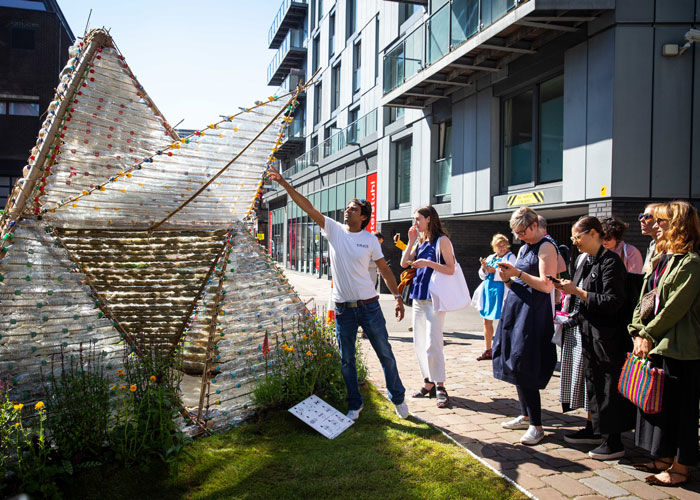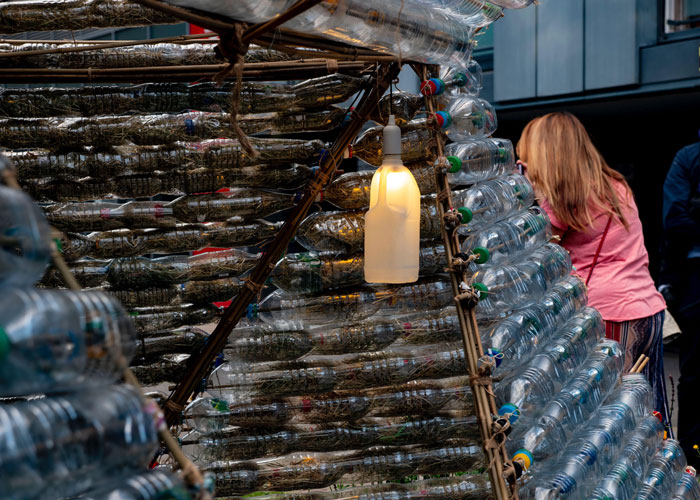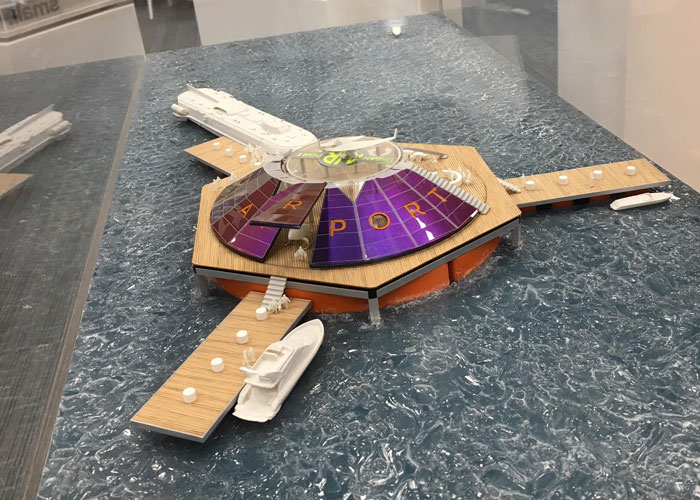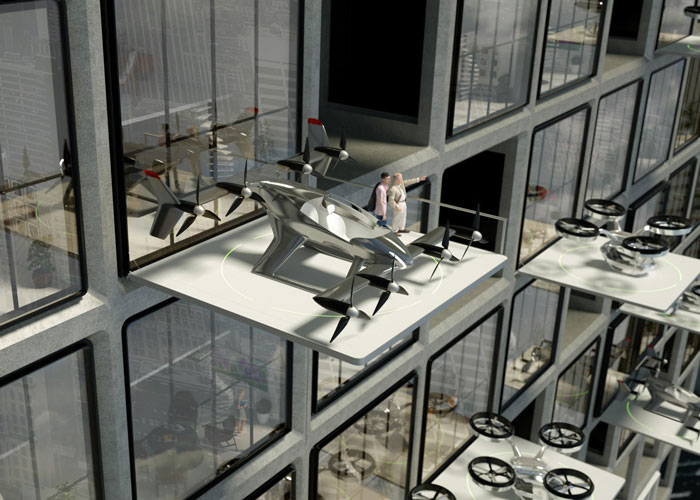Jim Biddulph & Ricky Sandhu, Six Miles Across London, In Conversation
Having worked as a lead architect for architectural design company Fosters + Partners for over 16 years, opening and working in offices around the world, Ricky Sandhu founded Six Miles Across London (small.) earlier this year.
The primary focus of the studio is to create innovation in the built environment and with it to tackle some of the world’s greatest challenges, not least natural disasters, the effects of global warming and harmful plastic waste. A brighter, healthier and more sustainable future is the aim but how does a small start up company even begin to take such steps? I spoke to Ricky to find out more about small. and his personal mantra that, “Vision with no action is a dream. Action with no vision is a nightmare.”

JB: I’d like to start with one of your projects with a physical end product, and also the one that first drew you to my attention during Clerkenwell Design Week 2019; BottleHouse. It’s an ambitious project that seeks to transform plastic waste into “bricks of the future” whilst offering shelter and jobs to those who may need them. Can you tell me a little more about it?
RS: The project, and as a result the foundation itself, grew out of a direct but ambitious question: How can we as architects and designers push our innovations in the built environment and apply them to more complex and difficult global challenges, in this case, plastic? The answer actually came about when my family and I were living in Doha, where I’d opened a new office Fosters + Partners Qatar office. Unfortunately, you have to drink bottled water out there and were generating 12 or so 2 litre bottles every single week. At the time there was no recycling other than a scheme that my son’s school had organised. Whilst that felt like a reasonably efficient way of disposing of them it led me thinking about how we might do something else with them. That led to my son and I testing out whether we could build something with them, and it was then that the idea of transforming them into a brick came about. By joining the body of bottles together in rows I realised that the overall surface creates a thermal envelope.
We added naturally grown bamboo for structure and then went about finding uses for all of the bottle components; the lids act as a bolt, the labels are used as a first fix solution and the bottoms, which we had to cut off in order to connect the main body of the bottle together, create a damp proof membrane under foot.
We’ve developed the design with big engineering firms and carried out a full engineering report on it, with which we found that because the bricks are full of air, which is warmed up all day and then redistributed, they actually act like and perform as well as double glazing.

JB: So what can we expect of the BottleHouse Foundation in the future?
RS: Each BottleHouse is completely modular and very easy to assemble, disassemble and move around, which make them the optimum transitional shelter or home. But the ultimate aim for the BottleHouse Foundation is to create a circular economy for plastic waste. Imagine a community where people could bring discarded plastic bottle to a Bottle House Hub and be remunerated and then those bottles be transformed by us to create functional built structures, be they for single person use right up to whole families. It would add a real value to plastic waste. What’s more, those in need will be provided them for free and will also have the added incentive of further remuneration if they bring them back to us after they’re done with them.
We think plastic should be really valuable and that’s particularly exciting when you realise that in the 6 short months since we launched the foundation we have offset 10,000 bottles from being burned, thrown into landfill or entering our oceans.
JB: Other projects, some of which are arguably even more ambitious, have not yet been realised but, like BottleHouse, are also focused upon creating infrastructure that is carbon neutral. Are you able to tell me about any of these?
RS: We’ve been working with Arup and Grid Serve to design the UK’s first fully electric car charging station. It’s a UK government funded project, which is actually already under construction and signifies a real shift in how we see and experience electric vehicles and transportation systems in general. It’s not a petrol station, so it doesn’t need to work in the same way – you don’t need high roofs to allow for fumes to aerate and you now have the option of introducing plants, even grass underfoot as there are no longer the same contaminants involved in refuelling your vehicle. It means the shape and feel of the space is very different and much more user friendly than what we’re used to in a petrol station. It can also be constructed from sustainable timber, and made from fewer materials because we’ve been able to lower those roofs and we’ve added PV panels on top, which provide the power necessary for running the lights and other non-charging related electric involved in the infrastructure. The other major drawback to ordinary petrol station is the lack of space for comfortable pedestrian access, so we’ve introduced what we can a pedestrian highway. It’s an important feature, as recharging ones car will naturally take longer than refuelling with petrol, so why not offer green spaces for people occupy, socialise or even work in whilst they wait? It will offer a transformation for what fuel stations can be in the future.

JB: That sounds very exciting, I can’t wait to use one in the future…I might need a vehicle to do so first though.
RS: Well, Urban AV is another new initiative we working on. It’s focused on vehicles themselves, specifically autonomous vehicles. We’ll be launching next year, so I can’t say too much now, but a driver for the project is that we need a more responsive, smaller and more agile vehicles, without the pollution and the risk of human error. A 13-tonne double decker bus in a small inner city street is not the future. Demand-responsive mobility is the aim. With that comes zero carbon and zero emission as well as zero hassle, as we’re designing an electric vehicle that saves you the £10,000 that it costs annually to have it sitting idle whilst not in use. The hope is that the technology involved in these vehicles will make them cheaper, whilst creating different types of jobs required in making the infrastructure work.
JB: One major drawback, sometimes used to pour cold water on the idea of an autonomous vehicle based future, is that there isn’t infrastructure in place to accommodate the vehicles themselves. How might we combat this point?
RS: It’s true; if we have these super-smart vehicles what are they going to drive on? Are they only going to go on the existing black asphalt roads? They absorb the suns heat, which warms up the local built environment; they’re impervious, meaning that all rain water gets channeled into our drainage system, putting pressure on that; they sand down our tires and create PM10 particles in the air whilst offering little else other than a surface to move along. So why can’t we design streets in the same way that we design buildings, pre-made in high calibre factories, bought to site and installed in an interchangeable modular format, so that whatever public resources are required can be supplied?
So for instance, can we capture and store rainwater for other uses, such as the reduction of fire risk? Or can the road surface be energy generating, not just a flat surface that you drive on? These are the drivers behind our Street of the Future project. It’s going to be a difficult one, because it is so ambitious in its vision and scope and will rely upon having an autonomous vehicle that suits it, namely one that is more efficient and with it far smaller in scale. Smaller vehicles means less space required for vehicle transportation which allows more room for greener infrastructure and other leisure based activities.

JB: And am I right in thinking that you’re already thinking beyond road-based transportation?
RS: Yes, Urban Air Port is infrastructure design to enable urban air mobility using drones, for both cargo and passengers. There are a number of people starting to design such vehicles, which are electric and have vertical take off capabilities, but they will require space with some of the same amenities as a regular airport – space to load and unload as well as taking off and landing. Following our mandate for everything else, we think it should also be lightweight, modular, highly sustainable, rapidly deployable as well as working in an urban environment where space might be limited.
In the parts of world that are going to be the most populace in the future, when there will be 11 billion people on earth; Africa, Latin and South America, India, Pakistan and China, which currently don’t have the infrastructure that we have today, Urban Air Ports can offer an alternative that is not carbon hungry. The same of course can be said of Streets of the Future. The same can also be said of places of emergency here in the present – can we help provide a safe means for transportation via modular sustainable streets and vehicles, of people, goods, medical supplies and any other materials that might be necessary?
JB: I can envisage some resistance to your ideas though; there are those that might immediately baulk at such ambitious plans, making the argument that there are the resources to carry them out.
RS: It works in the same way that the automobile was made democratically available with the invention of the Ford Model T and then governments found a way to built the infrastructure, in that case roads for the new technology. The beauty of what we are doing is that we are developing modular products that can be tweaked to suit the client or environment in which they will be used, which means they are entirely global in scope. Our products won’t need to be geographically specific; they can be taken up and used anywhere that will embrace them.
Essentially, we’re looking at the spaces in between buildings, the focus of which is mainly urban mobility and with that we can tackle one of the worst offenders when it comes to carbon emissions. Even though they are the lifeblood of our cities, our civic spaces and our streets are often neglected, nature is pushed out or forgotten and because of high levels of pollution and human error, a risk to our health. Our aim is to change that.




